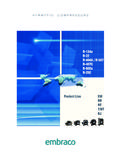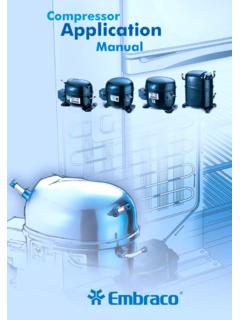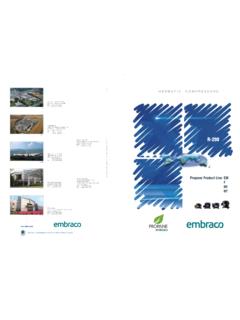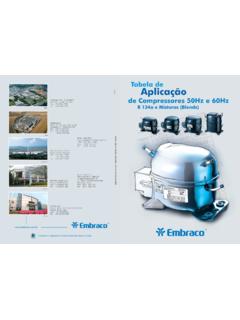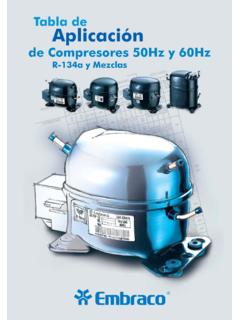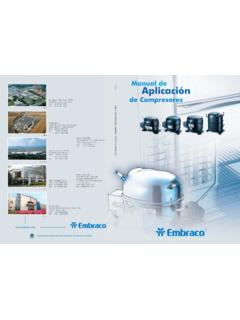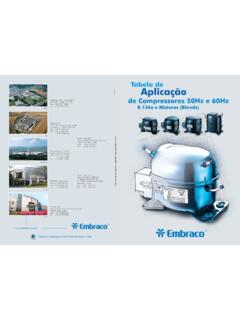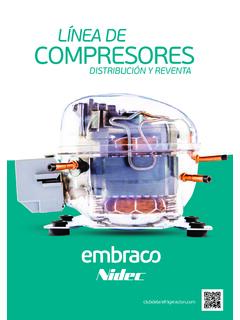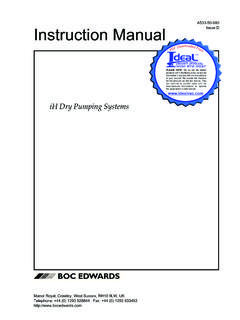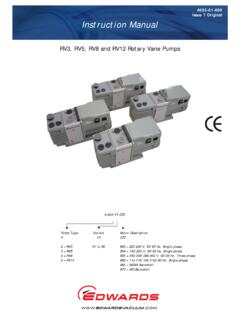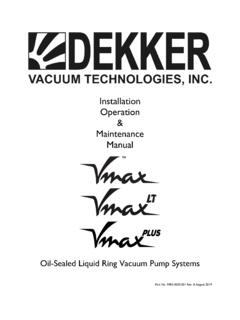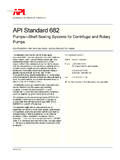Transcription of GUIDE FOR THE USE OF HCs REFRIGERANTS R600a AND R290 …
1 1 GUIDE FOR THE USE OF HCs REFRIGERANTS R600a AND R2903R600a and R290 are hydrocarbon REFRIGERANTS . They have consistent differences versus the HFCs or CHFCs that must be considered for designing, producing, testing, handling, storing, installing, repairing and disposing the applications, as well as for the workplaces and storage, with particular care to the flammability aspects and their consequences. A complete risk assessment of the use of HCs REFRIGERANTS must be carried out considering all the above points. It is also important to carefully consult the in use equipment manual. Only competent technicians trained on the safe use of flammable REFRIGERANTS are allowed to open refrigerant circuit or equipment housing of hydrocarbon systems.
2 Technicians using HCs must have available and know the meaning of the applicable Material Safety Data Sheets (MSDSs) and act / R600a SERVICE PROCESS SYSTEM DESIGNSAFETY & PRACTICALCOMPRESSOR REPLACEMENT4 SYSTEM DESIGNINTERNATIONAL SAFETY STANDARDSSTANDARDTITLEVALIDITY FORALLOWED MAX REFRIGERANT CHARGEIEC and EN60335-2-24 Applications for household refrigerators, ice cream appliances and ice makersHousehold appliances 150gIEC and EN60335-2-89 Commercial applications withincorporated or remote condensing unitsAll Commercial applications 150gEN 00378 Refrigerating systems and heat pumps safety and environmental requirementsAll refrigerators / freezers, air conditioners, heat pump.
3 Household, commercial, industrialVariable, according to the application and to the installation locationNOTE: Limit of 150g is for each separate refrigeration circuit. No restrictions in room size and occupancy more information on these equipment and parts requirements, look at these two standards refer to local legislation as STANDARDS FOR ELECTRICAL APPLIANCESSTANDARDTITLEIEC 60079-15 Electrical apparatus for explosive gas atmospheres Part 15: construction, testing and marking electrical components for use in explosive atmospheresSYSTEM DESIGN5(1) Highly flammable substances are defined by a flammability limit of less than or equal to kg/m3 at 21 C and 101 kPa or a heat of combustion greater than or equal to 19 kJ/kg; (according to ANSI/ASHRAE 34).
4 (2) Practical limit according to EN 378-: it is used if the HC refrigerant of the system can leak into an occupied R600a AND R290 GENERAL INFORMATION AND CHARACTERISTICSACCORDING TO EN378R600AR290 Chemical NameIsobutane (2-methylpropane)PropaneMolecular FormulaC4H10C3H8 Safety Class (1)A3A3 PED fluid group11 Practical Limit [kg/m3] (2) [kg/m3] [kg/m3] density 25 C, kPa [kg/m3] Mass [g/mol] Boiling Point [ C]0-42 ODP00 GWP [100 years ITH]43 Autoignition temperature [ C]365470 Critical Temperature [ C] Pressure [kPa abs] : HC REFRIGERANTS are classified in A3 Safety Class - lower toxicity, higher flammability, (according to ANSI/ASHRAE 34).NOTE: Limit of 150g is for each separate refrigeration circuit.
5 No restrictions in room size and occupancy have refrigerant identification and Risk of fire label CONDENSERSame as R404A / R134a system or slightly smallerEVAPORATORSame as R404A / R134a system In case of roll bond evaporator, check supplier s as R404A / R134a systemThe Embraco compressors for R600a and R290 have on the nameplate label - or as separate label - a warning symbol for flammable substances, even if they do not contain any REFRIGERANTS when delivered from Embraco refrigerant to be used is printed on the compressor label, also the compressor model includes a code identifying the refrigerant to be used. The R600a and R290 Embraco compressors are certificated by recognized testing agencies and adopt overload protectors and starting devices complying with the EN AND R290 IDENTIFICATION AND WARNING SYMBOLSHCs System Components5mm tubes or MCHE could help to minimize refrigerant chargeSYSTEM DESIGNR efrigerant ChargeMAX CHARGE 150gNOTE: Values are just indicative; the proper refrigerant charge depends on the system vs R134a/R404AR404A R290R134a R290R134a R600R600a vs R134a48% reduction41% reduction46% reductionFILTER DRYERSame as R404A / R134a system (XH-9)CAPILLARYSame as R404A / R134a or slightly longer (10-15%)EXPANSION VALVESS pecifically to R290.
6 Heat Exchangers with smaller channels can help to minimize refrigerant charge under 150 gramsFAN MOTORHas to be spark free (shaded pole or ECM)FAN BLADESMust be made in plastic or aluminium materialOTHER ELECTRICAL COMPONENTSHave to be approved according to IEC 60079-15 (2005)SYSTEM DESIGN7 SAFETY AND PRACTICAL8 Good ventilation is essential to reduce the potential of a flammable wear appropriate safety glasses and gloves when working with HCs and while brazing/unbrazing work area must be monitored with a hydrocarbon detector, located at low level, because HCs are heavier than precautions for serviceCommon sense and staying alert will go a long way towards working safely with flammable conduct a risk assessment to determine whether it is appropriate to use a flammable gas refrigerant in the particular REFRIGERANTS do not have an odorant.
7 So leaks can t be identified by quality combustible gas leak detector is mandatory for HC service work area must be free from sources of ignition such as naked flames and sparking electrical the presence of fire extinguisher safe zone also applies around a vacuum pump because it could discharge some residual HC gas during sensor should provide an audible and visual alarm of HC in the air, well before there is enough to form a flammable mix (approximately 2% of HC in air by volume).SAFETY AND PRACTICAL9 SPECIFICATION OF TOOLS AND EQUIPMENTFor internal areas forced ventilation is required by a fan rated for explosives atmospheresUse only tools and equipment certified for use in hazardous areas.
8 ( vacuum pump, electrical components and parts, original replacement parts).Normal vacuum pumps can be used if outside the flammable zone but the on/off switch must not be used, as this is usually the only ignition source in most pumps. It is anyway recommended to have a HC specific leak detectors rated for combustible gas, if the leak cannot be located with a electronic detector, remove the charge, purge and fill with nitrogen and use a micro leak detector an antistatic-electricity case of replacement of electrical parts inside the cabinet ( neon lamp, thermostat, etc.):Sweep the worksite with the HC gas detectorDisconnect the main electrical supply Open the refrigerator doors and keep them open for a few minutesREPLACEMENT OF ELECTRICAL PARTSUse recovery machines specifically designedfor HCs (they can also be used with HFCs).
9 Recovery cylinders: be specific for HC (pressure rating and the compatibility of valve seals, etc).Always check local requirements for handling, storage and RECOVERY MACHINES FOR HFCS MUST NOT BE USED WITH HC REFRIGERANTS BECAUSE OF SOURCES OF IGNITION SUCH AS SWITCHES, HIGHAND LOW PRESSURE CONTROLS AND AND PRACTICALSAFETY AND PRACTICAL11 Replace failed components using original equipment partsClose the doors and connect the refrigeration equipment to power sourceNOTE: HCs are heavier than air, so if there is an internal leakage, there could be a high concentration of refrigerant in the bottom of the cabinet, creating a flammable of cabinetHC leaks from evaporator to the internal compartment can form a flammable source of ignition (thermostat, on/off switches, etc.)
10 May produce a flame or explosion. All electrical devices must be encapsulated or fire and explosion of cabinetThe possibility of HC leakage external of the cabinet forming a flammable mixwith air is remote, considering the small charge. Built-in systems inside another structure are more susceptible to this cabinet from electrical the protective cover to access the all the compressor electrical a needle valve on the service tube. Connect a schrader valve in order to start the venting the refrigerant by venting it in the atmosphere in an outside ambient away from heat and ignition RemovalCOMPRESSOR REPLACEMENTWARNING:During the refrigerant recovery (and generally when filling a vessel) take care to the amount (weight) of Refrigerant put in the vessel and to the weight of the vessel itself.

